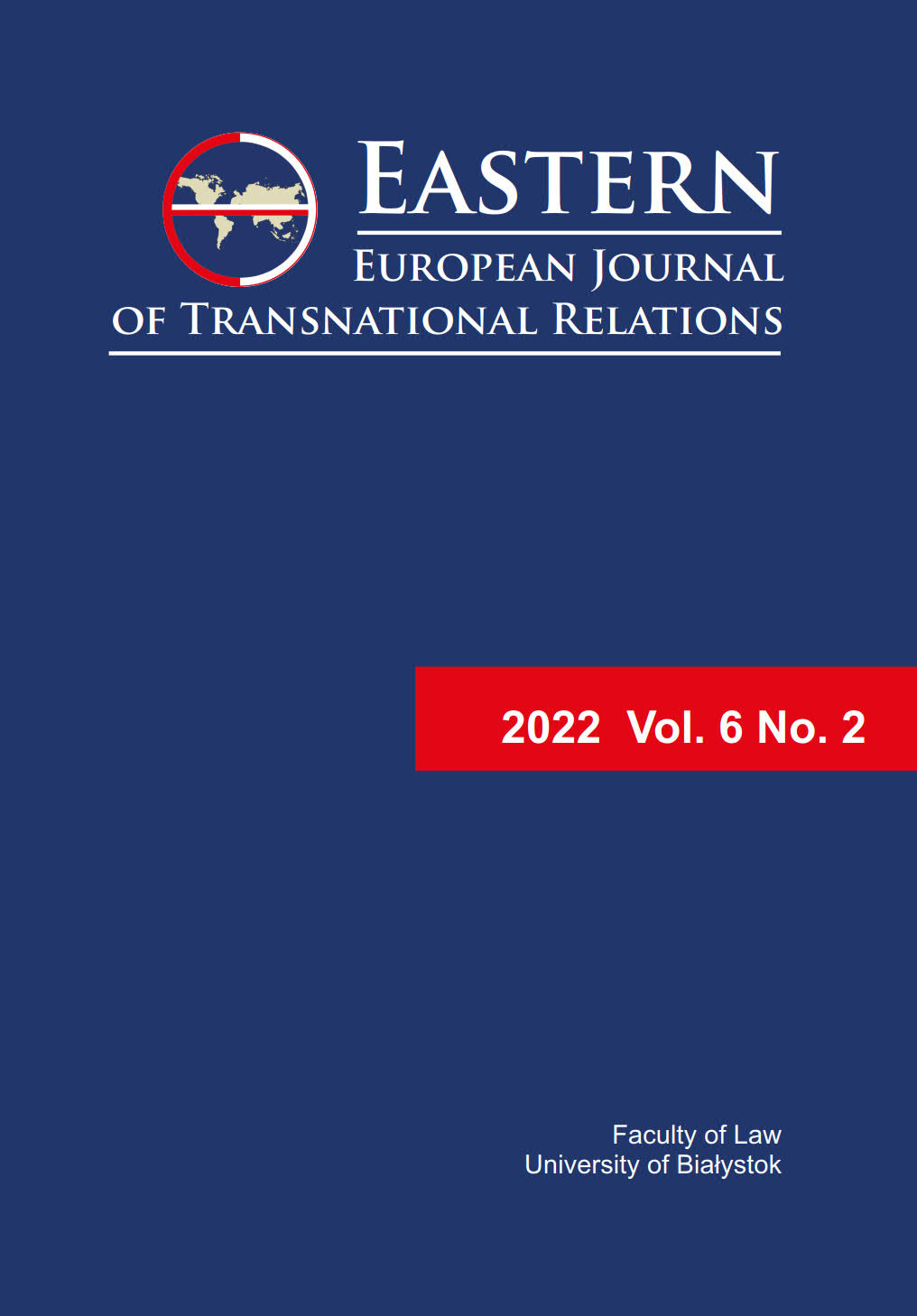Crime against the natural environment – ecocide – from the perspective of international law
DOI:
https://doi.org/10.15290/eejtr.2022.06.02.01Keywords:
ecocide, environmental protection, international law, environmental crimeAbstract
Deep, human induced, environmental changes become a global danger for the whole population. A form of reaction to those dangers as well as possibility of reversing the risks can be a deeper insight into the legal instruments of environmental liability – including the criminal liability for environmental harm. While national legal systems seem to succeed in introducing instruments of criminal liability of environmental crimes, the international law seems not to follow this trend. It is even hard to specify what constitutes the environmental crime according to international law. The evolution of international law in this field has shown many and unsuccessful attempts to bring environmental crimes into the catalogues of crimes recognized by international law. The most promising fora for identification of international crimes against environment seems to be the International Criminal Court (ICC). Potential use of ICC for identification and effective realization of criminal liability of environmental damage has however its limits.
Downloads
References
Angus, I. (2016). Facing the Anthropocene. Fossil Capitalism and the Crisis of the Earth System. Monthly Review Press.
Berat, L. (1993). Defending the right to a healthy environment: towards a crime of geocide in international law. Boston University International Law Journal, 11, 327-348.
Bińczyk, E. (2018). Epoka Człowieka. Retoryka i marazm antropocenu. PWN.
Crook, M. & Short Marx, D. (2014). Lemkin and Gencide-Ecocide Nexus. The International Journal of Human Rights, 18(3), 298-319. https://doi.org/10.1080/13642987.2014.914703.
Crutzen, P.J. & Stoermer, E.F. (2000). The „Antrhropocene”. Global Change Newsletter, 41, 17-18, Retrieved from http://www.igbp.net/download/18.316f18321323470177580001401/1376383088452/NL41.pdf.
Freeland, S. (2005). Human Rights, the Environment and Conflict: addressing crimes against the environment. Revista international de direitos humanos, 2(2), 112-139. https://doi.org/10.1590/S1806-64452005000100006.
Gillet, W. (2017). Eco-Struggles: Using International Criminal Law to Protect the Environment During and After Non-International Armed Conflict. In C. Stahn, J. Iverson & J. Easterday (Eds), Environmental Protection and Transitions from Conflict to Peace: Clarifying Norms, Principles, and Practices (pp. 220-254). Oxford University Press.
Gray, M. (1996). The international Crime of Ecocide. California Western International Law Journal, 26(2), 215-271. Retrieved from https://scholarlycommons.law.cwsl.edu/cwilj/vol26/iss2/3.
Greene, A. (2019). The Campaign to Make Ecocide an International Crime: Quixotic Quest or Moral Imperative?. Fordham Environmental Law Review, 30(3), 1-48. Retrieved from https://ir.lawnet.fordham.edu/elr/vol30/iss3/1.
Hanson, T. (2009). Warfare in Biodiversity Hotspots. Conservation Biology, 23(3), 578-587. Retrieved from https://www.jstor.org/stable/29738774.
Higgins, P., Short, D. & South, N. (2013). Protecting the planet.: a proposal for a low of ecocide. Crime, Law and Social Change, 59(3), 251-266. https://doi.org/10.1007/s10611-013-9413-6.
Kenig-Witkowska, M. (2011). Międzynarodowe prawo środowiska. Wybrane zagadnienia systemowe. Wolters Kluwer.
Killean, R. (2021). From ecocide to eco-sensitivity: “greening” reparations at the International Criminal Court. The International Journal of Human Rights, 25(2), 323-347. https://doi.org/10.1080/13642987.2020.1783531.
Moffet, L. (2014). Justice for Victims before the International Criminal Court. Routledge.
Nyka, M. (2017). Prawne aspekty przezorności w międzynarodowoprawnej ochronie środowiska. Gdańskie Studia Prawnicze, XXXVIII, 501-511. Retrieved from https://prawo.ug.edu.pl/sites/prawo.ug.edu.pl/files/_nodes/strona/33461/files/38nyka.pdf.
Politi, M. (2012). The ICC and the Crime of Aggression. Journal of International Criminal Justice, 10(1), 267-288. https://doi.org/10.1093/jicj/mqs001.
Radecki, W. (2002). Odpowiedzialność prawna w ochronie środowiska. Difin.
Sands, P., Peel, J., Fabra, A. & MacKenzie, R. (2012). Principles of International Environmental Law (3rd ed.). Cambridge University Press. https://doi.org/10.1017/CBO9781139019842.
South, N. (2010). The ecocidal tendencies of late modernity: trans-national crime, social exclusion, victims and rights. In R. White (Ed.), Global environmental harm: criminological perspective (pp. 228-248). Willan.
Downloads
Published
Issue
Section
License
Copyright (c) 2023 Maciej Nyka

This work is licensed under a Creative Commons Attribution 4.0 International License.
1. The Author declares that he or she has created the written work and holds exclusive and unlimited copyright /both moral and property rights/ and guarantees that no third parties have rights to the work.
2. In the view of the Copyright and Related Rights Act, a work must fulfill the following criterion:
a) be a manifestation of creative work,
b) have an individual character („author’s personal stamp”),
c) have a set form.
3. The Author declares that the text has not been previously published (under the same or different title, or as a part of another publication).
4. The Author allows (grants a non-exclusive license) the publishing house of University of Białystok to use the scholarly text to:
- preserve and multiply by means of any technique; save in a digital form with no limitations as to the manner and form of digital preservation;
- upload online with no limitations as to the place and time of access.
5. The Author grants consent for editorial changes made in the work.
6. The Author grants the University of Białystok rights free of charge for the duration of property copyright with no territory limits. The University has the right to grant sublicenses in the acquired rights.
7. Granting a non-exclusive license allows the Author to preserve their rights and allows other parties to make use of the work according to sublicensing agreement with provisions identical as those of Attribution 4.0 Internacional License (CC BY 4.0), available online at: https://creativecommons.org/licenses/by/4.0/.
8. The Agreement has been concluded for an indefinite period of time.
9. Because of costs born in preparation of the work for publishing, the Parties oblige themselves to act in good faith and refrain from declining to grant licenses.
10. To all matters not settled herein, provisions of the Civil Code and Copyright and Related Rights Act of 1994, February 4 shall apply.
11. All disputes shall be resolved by a court of local jurisdiction for the place of seat of University of Białystok.


